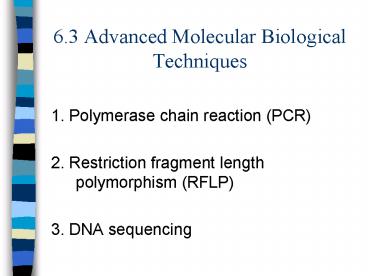6.3 Advanced Molecular Biological Techniques - PowerPoint PPT Presentation
1 / 15
Title:
6.3 Advanced Molecular Biological Techniques
Description:
6.3 Advanced Molecular Biological Techniques 1. Polymerase chain reaction (PCR) 2. Restriction fragment length polymorphism (RFLP) 3. DNA sequencing – PowerPoint PPT presentation
Number of Views:1186
Avg rating:3.0/5.0
Title: 6.3 Advanced Molecular Biological Techniques
1
6.3 Advanced Molecular Biological Techniques
- 1. Polymerase chain reaction (PCR)
- 2. Restriction fragment length polymorphism
(RFLP) - 3. DNA sequencing
2
Polymerase Chain Reaction (PCR)
- Until the late 1980s, many copies of a desired
DNA fragment could only be made by inserting the
DNA sequence into plasmids - Problem The plasmids had to be extracted from
bacteria, and then the desired DNA fragment had
to be excised - Solution Direct method of making copies of a
desired DNA sequence, called polymerase chain
reaction (PCR) Kary Mullins, 1985
3
Polymerase Chain Reaction (PCR)
- PCR Amplification of DNA sequence by repeated
cycles of strand separation and replication - Small sample of DNA can be amplified to make
multiple copies of a desired DNA fragment - Each PCR cycle doubles the copies of a desired
DNA fragment, resulting in exponential growth - ie. after 30 cycles, gt 1 000 000 000 copies (230)
are made
http//users.ugent.be/avierstr/principles/pcrcopi
es.gif
4
Polymerase Chain Reaction (PCR)
- One cycle
- Double-stranded DNA is denatured using heat
(94oC96oC) to separate strands by breaking
hydrogen bonds - No DNA helicase or DNA gyrase
- DNA primers (5-3) anneal to complementary
template DNA that bracket the desired DNA
sequence (50oC65oC) - No RNA primer
- Taq polymerase add complementary nucleotides to
synthesize the new DNA strand (72oC) - No DNA polymerase III
- Repeat cycle (steps 1-3)
http//croptechnology.unl.edu/animationThumbnails/
1020458324.gif
http//www.cbs.dtu.dk/staff/dave/roanoke/genetics9
80211.html
5
PCR Length of DNA strands
- Targeted DNA sequence is not completely isolated
in the first few cycles of PCR - Variable-length strands Mixture of replicated
DNA strands of unequal length - After first cycle, variable-length strands start
at target region on one end and extends beyond
the target region on the other end - Constant-length strands Mixture of replicated
DNA strands of equal length - After second cycle, two of the replicated strands
start at target region on one end and terminates
at target region on the other end - By third cycle, number of copies of targeted DNA
strands increases exponentially
6
www.maxanim.com/genetics/PCR/PCR.htm
7
Restriction Fragment Length Polymorphism (RFLP)
- Polymorphism
- any difference in DNA sequence (coding or
non-coding) that can be detected between
individuals - Restriction Fragment Length Polymorphism Analysis
- technique that compares different lengths of DNA
fragments produced by restriction endonucleases
to determine genetic differences between
individuals by using complementary radioactive
probes
8
Restriction Fragment Length Polymorphism Analysis
- Digest DNA using restriction enzyme(s)
- Run digested DNA on gel using gel electrophoresis
- Smear - Many DNA fragments with slight
differences in length - Expose gel to a chemical to denature
double-stranded DNA to become single-stranded - Southern blotting
9
RFLP Analysis
- 4. Southern blotting
- Transfer DNA from gel to nylon membrane
- Expose nylon membrane to solution with
radioactive complementary nucleotide probes that
hybridize to specifically chosen DNA sequences on
nylon membrane - Place nylon membrane against X-ray film, where
hybridized radioactive probes cause exposure of
X-ray film, producing an autoradiogram
http//www.cbs.dtu.dk/staff/dave/roanoke/genetics9
80211.html
10
RFLP analysis
- Differences in pattern to detect polymorphisms
Animation
11
DNA Sequencing
- Determine sequence of base pairs for genes
- Sanger dideoxy method DNA sequencing technique
based on DNA replication using dideoxynucleoside
triphosphate
http//www.sanger.ac.uk/Info/Intro/gfx/fred_bw.jpg
12
Sanger dideoxy method
- Into 4 reaction tubes, add
- Double-stranded DNA to be sequenced is denatured
to become single-stranded - Radioactively labelled primer to end of the DNA
template - DNA polymerase
- Free nucleotides (dATP, dTTP, dGTP, dCTP)
- Into each of the 4 reaction tubes, add a
different radioactively labelled dideoxy analogue
(nucleoside triphosphate that has no hydroxyl
group on the 2 and 3 carbon of ribose sugar)
13
Sanger dideoxy method
- If dideoxy analogue is missing 3-OH on the
deoxyribose sugar, DNA polymerase cannot add the
next complementary base?synthesis stops
- Chain termination resulting in different DNA
fragment lengths - Separate different DNA lengths by gel
electrophoresis, loading each reaction tube in a
separate well/lane - Sequence can be read from the gel in ascending
order
http//www.cbs.dtu.dk/staff/dave/roanoke/genetics9
80211.html
14
Sanger Method Animation
- http//www.mefeedia.com/watch/21777157
15
Human Genome Project
- To determine the genetic sequence of the 46 human
chromosomes - Used similar sequencing technique, but used
fluorescently tagged ddNTPs that could be read by
a computer

